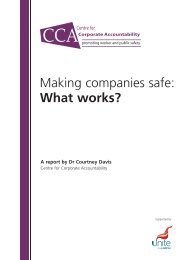Manual Handling Manual Handling Operations Regulations 1992 ...
Manual Handling Manual Handling Operations Regulations 1992 ...
Manual Handling Manual Handling Operations Regulations 1992 ...
Create successful ePaper yourself
Turn your PDF publications into a flip-book with our unique Google optimized e-Paper software.
Health and Safety<br />
Executive<br />
(e)<br />
educate, inform and consult your workforce:<br />
(i)<br />
(ii)<br />
(iii)<br />
have you consulted safety representatives/other workers and involved<br />
them in the risk assessment process?<br />
have you educated and informed your workforce to enable them to play<br />
an active part in controlling risk?<br />
what steps have you taken to ensure that training reinforces safe working<br />
practices and control measures?<br />
(f)<br />
manage any case of manual handling injury:<br />
(i)<br />
(ii)<br />
(iii)<br />
(iv)<br />
have you implemented and supported a system for early reporting of<br />
manual handling injuries and investigating which work activities could be<br />
linked with the symptoms?<br />
do you actively look for symptoms of manual handling injury?<br />
have you arranged for occupational health provision?<br />
do you have systems in place for employees returning to work<br />
after having a manual handling injury, including a review of the risk<br />
assessment in light of their individual needs?<br />
(g)<br />
carry out regular checks on programme effectiveness:<br />
(i)<br />
(ii)<br />
(iii)<br />
(iv)<br />
do you have systems in place to monitor and review your controls for<br />
reducing the risks from manual handling?<br />
do you have systems in place to monitor and review your manual<br />
handling management programme?<br />
are you aware of new developments/information?<br />
do you aim for continuous improvement?<br />
3 Adequate control of risk factors will go a long way to prevent the occurrence<br />
of ill health caused by manual handling. Due to individual differences it is not<br />
possible to ensure that every possible manual handling injury will always be<br />
prevented. It is therefore important that employers should have a system in place<br />
to detect and manage any cases of work-related manual handling injury. Such<br />
systems should:<br />
(a)<br />
(b)<br />
(c)<br />
(d)<br />
encourage the early reporting of any symptoms. An individual’s willingness<br />
to do this varies, so it is important to establish a supportive climate in the<br />
workplace that emphasises the benefits of early detection of possible harm;<br />
provide appropriate advice for users who report symptoms;<br />
provide for referral to health professionals to obtain appropriate diagnosis,<br />
treatment, or advice; and<br />
help employees who report symptoms to continue working, or to return to<br />
work after periods of absence or treatment. Rehabilitation must be supported<br />
by graduated return to work schemes.<br />
<strong>Manual</strong> handling Page 54 of 90
















